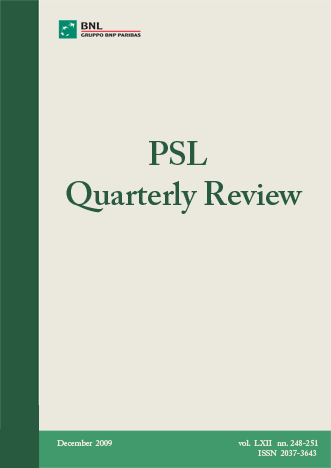Asset inflation and monetary policy
DOI:
https://doi.org/10.13133/2037-3643/9440Keywords:
Financial Crisis, Instability, Asset InflationAbstract
Asset inflation is characterised by an increase in the prices of assets while output prices are relatively stable or on a decline. In the event of asset inflation, international coordination of monetary policy is an observable trend. For instance, in 1989, when Japan was at the worst phase of the recession, the Bank of Japan lowered interest rates and the US and German discount rates also declined at the same time. However, most mainstream economists believe that monetary policy should be aimed at the stability of the general price level rather than zeroing on asset prices. The nature, importance and historical evolutionary of concern with asset inflation are discussed. Paper originally published in the BNL Quarterly Review, vol. 48 n. 192, March, 1995 pp. 17-37.
JEL Codes: F3, G1, N1, B5
References
AKERLOF G.A. and ROMER P.M. (1993), "Looting: the economic underworld of bankruptcy for profit", Brookings Papers on Economic Activity.
AKERLOF G.A. and ROMER P.M. (1993), "Looting: the economic underworld of bankruptcy for profit", National Bureau of Economic Research, Reprint no. 1868, pp. 1-73.
BANK FOR INTERNATIONAL SETTLEMENTS (1986), Recent Innovations in International Banking, prepared by a Study Group, Sam Y. Cross, Federal Reserve Bank of New York, Chairman, estàblished by the Central Banks of the Group of Ten Countries, Basle.
BANK FOR INTERNATIONAL SETTLEMENTS (1991), Annual Report, Basle.
BANK FOR INTERNATIONAL SETTLEMENTS (1992), Annual Report, Basle.
BANK FOR INTERNATIONAL SETTLEMENTS (1993), Annual Report, Basle.
BANK FOR INTERNATIONAL SETTLEMENTS (1994), Annual Report, Basle.
BORIO C.E.V., KENNEDY N. and PROWSE S.D. (1994), "Exploring aggregate price fluctuations across countries: measurement, determinants and monetary policy implications", BIS Economic Papers, no. 40, April, pp. 1-101.
CAMPBEL J.Y. (1994a), "Asset pricing", NBER Reporter, Program Report, Spring, pp. 1·4.
CAMPBELL J.Y. (1994b), "The New Palgrave Dictionary of Money and Finance", Journal of Economic Literature, 32 (2), pp. 667-73.
CAMPBELL J.Y. (1994c), "What moves the stock market?", NBER Reporter, Research Summaries, Fall, pp. 8-10.
CASE K.E. and SHILLER R. (1986), "The behavior of home buyers in boom and post-boom markets", New England Economic Review, November-December, pp. 29-46.
CHANDLER L.V. (1956), Benjamin Strong, Central Banker, Washington: Brookings Institution.
THE ECONOMIST (1994), vol. 332, No. 7877, August 20.
FRIEDMANM. and SCHWARTZ J.A. (1963), A Monetary History of the United States, 1867-1960, Princeton: Princeton University Press.
HOYT H. (1933), One Hundred Years of Land Values in Chicago: The Relationship of the Growth of Chicago to the Rise of its Land Values, 1830-1933; Chicago: University of Chicago Press.
INTERNATIONAL MONETARY FUND (1992), International Financial Statistics, Washington.
JAMES H. (1994), "International monetary cooperation since Bretton Woods," draft manuscript, October.
KEIZAI KOHO CENTER (1994), Japan, 1994: An International Comparison, Tokyo.
KEYNESM.J. (1930), A Treatise on Money, 2 vols., New York, Harcourt, Brace.
KEYNES M.J. (1936), The General Theory of Employment, Interest and Money, New York: Harcourt, Brace.
KINDLEBERGER C.P. (1986), The World in Depression, 1929-1939, revised edition, Berkeley: University of California Press.
KINDLEBERGER C.P. (1989), Manias, Panics and Crashes: A History of Financial Crises, 2nd edition, New York: Basic Books.
KINDLEBERGER C.P. (1991), "International (and interregional) aspects of financial crises", in Martin Feldstein ed., The Risk of Economic Crisis, Chicago: University of Chicago Press, pp. 128-32.
KINDLEBERGER C.P. (1992), Mariners and Markets, New York: Harvester/ Wheatsheaf.
KINDLEBERGER C.P. (1993), A Financial History of Western Europe, 2nd edition, New York: Oxford University Press.
KORTY RESEArch (1994), Investment Direction, October.
MCKINNON R.I. (1973), Money and Capital in Economic Development, Washington: Brookings Institution.
MCKINNON R.I. (1994), The Order of Economic Liberalization: Financial Control in the Transition to a Market Economy, 2nd edition, Baltimore: Johns Hopkins University Press.
MUNDELL R.A. and SWOBODA A.K. eds. (1969), Monetary Problems of the International Economy, Chicago: University of Chicago Press. NBER Reporter, various issues, Cambridge, Mass. New York Times, various issues.
REED M.C. (1975), Investment in Railways in Britain: A Study in the Development of the Capital Market, London: Oxford University Press.
SELGIN G. (1986), The Theory of Free Banking, Totowa: Rowan and Littlefield.
SHAW E.S. (1973), Financial Deepening in Economic Development, New York: Oxford University Press
SMITH G.D. and SYLLA R. (1993), "The transformation of financial capitalism: an essay on the history of American capital markets", Financial Markets, Institutions and Instruments, 2 (2), pp. 1-62.
SMOLER F. (1994), "A view from the Fed: an interview with Paul A. Volcker", Audacity, 3 (1), Fall, pp. 6-15.
SUMMERS L.H. (1985), "On economics and finance", Journal of Finance, 11 (3), July, pp. 633-65.
TINBERGEN J. (1965), On the Theory of Economic Policy, 2nd edition, Amsterdam: North Holland.
VAN HORNE J.C. (1985), "Financial innovation and excesses", Journal of Finance, 11 (3), Ju1y, pp. 621-31.
VOLCKER P.A. and TOYOO G. (1992), Changing Fortunes: The World's Money and the Threat to American Leadership, New York: Times Books.
Downloads
Published
How to Cite
Issue
Section
License



